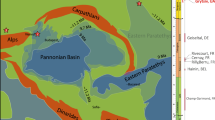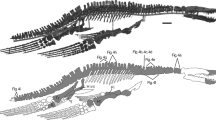Abstract
Nearly 70% of the 535 species of salamanders in the world are members of a single family, the Plethodontidae, or lungless salamanders1. The centre of diversity for this clade is North and Middle America, where the vast majority (99%) of species are found. We report the discovery of the first Asian plethodontid salamander, from montane woodlands in southwestern Korea. The new species superficially resembles members of North American genera, in particular the morphologically conservative genus Plethodon. However, phylogenetic analysis of the nuclear encoded gene Rag-1 shows the new taxon to be widely divergent from Plethodon. The new salamander differs osteologically from putative relatives, especially with respect to the tongue (attached protrusible) and the derived tarsus2,3,4,5,6. We place the species in a new genus on the basis of the morphological and molecular data. The distribution of the new salamander adds to the enigma of Old World plethodontids, which are otherwise restricted to the western Mediterranean region7,8, suggesting a more extensive past distribution of the family.



Similar content being viewed by others
References
AmphibiaWeb [online] (http://amphibiaweb.org) (Berkeley, California, 2005).
Wake, D. B. Comparative osteology and evolution of the lungless salamanders, family Plethodontidae. Memoirs, South. Calif. Acad. Sci. 4, 1–111 (1966)
Wake, D. B. & Elias, P. New genera and a new species of Central American salamanders, with a review of the tropical genera (Amphibia, Caudata, Plethodontidae). Contrib. Sci. Nat. Hist. Mus. Los Angeles Co. 345, 1–19 (1983)
Lombard, R. E. & Wake, D. B. Tongue evolution in the lungless salamanders, family Plethodontidae. II. Function and evolutionary diversity. J. Morphol. 153, 39–80 (1977)
Wake, D. B. & Deban, S. M. in Feeding (ed. Schwenk, K.) 95–116 (Academic, San Diego, 2000)
Shubin, N. H. & Wake, D. B. in Amphibian Biology Vol. 5 (eds Heatwole, H. & Davies, M.) 1782–1808 (Surrey Beatty & Sons, Chipping Norton, Australia, 2003)
Wake, D. B., Maxson, L. R. & Wurst, G. Z. Genetic differentiation, albumin evolution, and their biogeographic implications in plethodontid salamanders of California and southern Europe. Evolution 32, 529–539 (1978)
Larson, A., Weisrock, D. W. & Kozak, K. H. in Reproductive Biology and Phylogeny of the Urodela (ed. Sever, D.) 31–108 (Science Publishers, Enfield, New Hampshire, 2003)
Brodie, E. D. Jr Western salamanders of the genus Plethodon: systematics and geographic variation. Herpetologica 26, 468–516 (1970)
Chippindale, P. T., Bonett, R. M., Baldwin, A. S. & Wiens, J. J. Phylogenetic evidence for a major reversal of life history evolution in plethodontid salamanders. Evolution 58, 2809–2822 (2004)
Mueller, R. L., Macey, J. R., Jaekel, M., Wake, D. B. & Boore, J. L. Morphological homoplasy, life history evolution, and historical biogeography of plethodontid salamanders inferred from complete mitochondrial genomes. Proc. Natl Acad. Sci. USA 101, 13820–13825 (2004)
Wen, J. Evolution of eastern Asian and eastern North American disjunct distributions in flowering plants. Annu. Rev. Ecol. Syst. 30, 421–455 (1999)
Xiang, Q.-Y. et al. Regional differences in rates of plant speciation and molecular evolution: a comparison between eastern Asia and eastern North America. Evolution 58, 2175–2184 (2004)
Xiang, Q.-Y., Soltis, D. E. & Soltis, P. S. The eastern Asian and eastern and western North American floristic disjunction: congruent phylogenetic patterns in seven diverse genera. Mol. Phylogenet. Evol. 10, 178–190 (1998)
Tihen, J. A. & Wake, D. B. Vertebrae of plethodontid salamanders from the Lower Miocene of Montana. J. Herpetol. 15, 35–40 (1981)
Rasmussen, D. L. & Prothero, D. R. in Cenozoic Systems of the Rocky Mountain Region (eds Raynolds, R. G. & Flores, R. M.) 479–499 (Rocky Mountain Section, Society for Sedimentary Geology, Denver, 2003)
Wallace, S. C. & Wang, X. Two new carnivores from an unusual late Tertiary forest biota in eastern North America. Nature 431, 556–559 (2004)
Jenkyns, H. C., Forster, A., Schouten, S. & Sinninghe Damsté, J. S. High temperatures in the Late Cretaceous Arctic Ocean. Nature 432, 888–892 (2004)
Acknowledgements
We thank S. Karsen for bringing these salamanders to our attention. R. Diaz, K. Klitz and W. Korff assisted with illustrations. Radiographs were obtained with the assistance of B. M. Burr and M. R. Thomas. J. Lazell, R. Mueller, D. Rasmussen, E. Rosenblum, M. Stöck, V. Vredenburg and M. Wake offered assistance and information. Research was supported by a NSF AmphibiaTree grant.
Author information
Authors and Affiliations
Corresponding author
Ethics declarations
Competing interests
The authors declare that they have no competing financial interests.
Supplementary information
Supplementary Methods
This file contains details on DNA sequencing, phylogenetic methods and specimens used for molecular analyses. It also contains additional references. (DOC 63 kb)
Rights and permissions
About this article
Cite this article
Min, M., Yang, S., Bonett, R. et al. Discovery of the first Asian plethodontid salamander. Nature 435, 87–90 (2005). https://doi.org/10.1038/nature03474
Received:
Accepted:
Issue Date:
DOI: https://doi.org/10.1038/nature03474
- Springer Nature Limited
This article is cited by
-
Functional group analyses of herpetofauna in South Korea using a large dataset
Scientific Data (2023)
-
The Asian plethodontid salamander preserves historical genetic imprints of recent northern expansion
Scientific Reports (2021)
-
Climate change-based models predict range shifts in the distribution of the only Asian plethodontid salamander: Karsenia koreana
Scientific Reports (2019)
-
Global hotspots in the present-day distribution of ancient animal and plant lineages
Scientific Reports (2015)
-
Rapid Evolution of Plethodontid Modulating Factor, a Hypervariable Salamander Courtship Pheromone, is Driven by Positive Selection
Journal of Molecular Evolution (2010)





